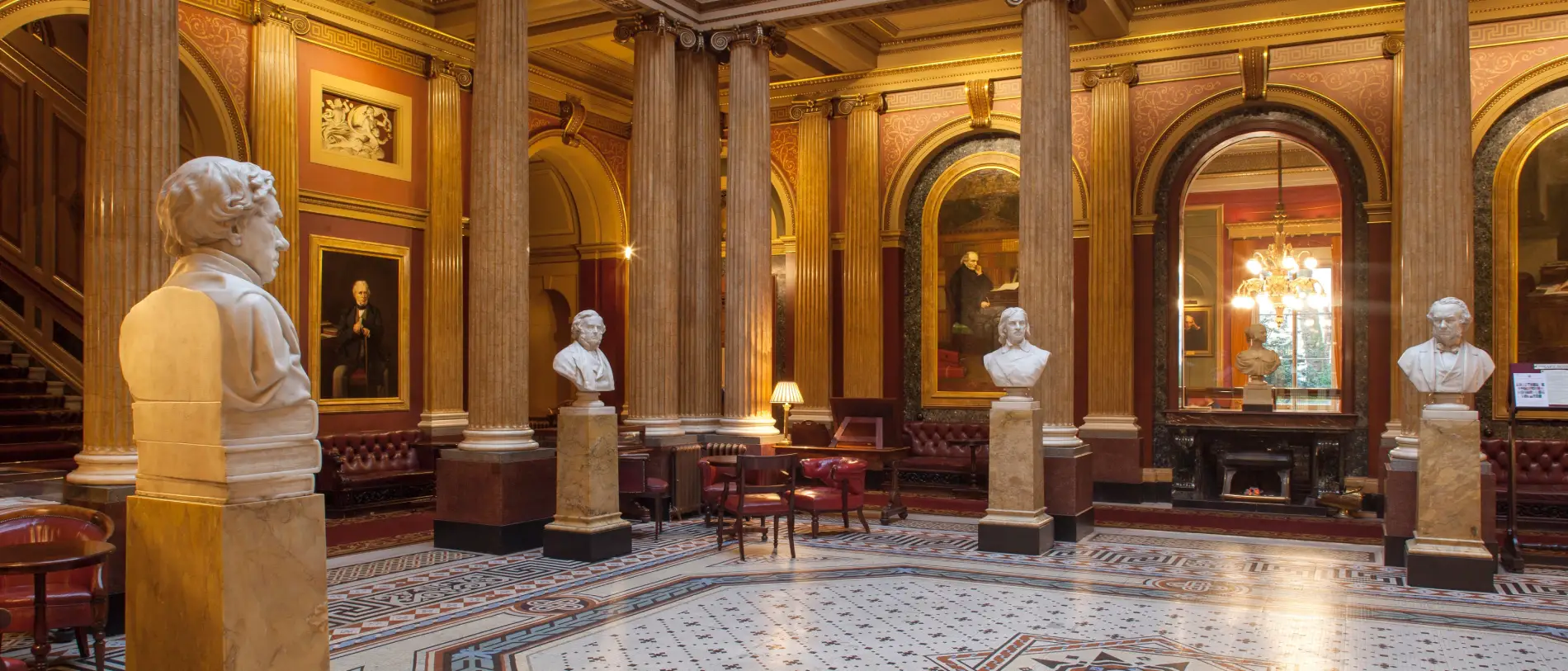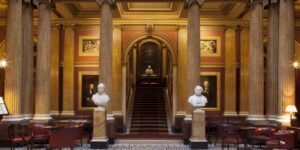CONNECTED LIGHT DELIVERS ‘VIBRANT, ALIVE’ LIGHTING FOR LONDON’S GRADE 1 LISTED REFORM CLUB
A sensitive heritage lighting upgrade is providing a warm, three-dimensional glow at one of London’s most unique and distinguished private members’ clubs.
Established in 1836, the Reform Club in Pall Mall is one of London’s – and arguably one of the world’s – most celebrated private members’ clubs. Today its membership numbers nearly 3,000 people, drawing on the worlds of politics, business and the arts. Among its many other attributes, the gorgeous, Italian Renaissance-style building also includes one of the largest private libraries in England – at last count exceeding 85,000 volumes.
The Club recently underwent a remarkable, historically sensitive restoration initiative, under the project leadership of club member Anthony Capo-Bianco. The Club is home to an important collection of art, and of particular focus was to restore vibrancy to a number of magnificent spaces within the building, notably The Grand Saloon (which sports multiple galleried landings and an imposing Atrium) and the Library – considered to be the Club’s ‘jewel in the crown’. Capo- Bianco’s vision was to bring these historically important Grade 1 listed interiors back to life through a thoughtful conservation approach. Right from the start, it was determined that lighting was to play a pivotal role in the refurbishment, with Capo-Bianco seeking a soft, warm, three-dimensional glow that would attract visitors to look at architectural details, artworks and paintings through fresh eyes.
HERITAGE LIGHTING SOLUTION
Bespoke lighting technology and solutions specialist Connected Light was enlisted to devise a new lighting specification for the space. This was never likely to be a straightforward project – as a Grade I building, the club is the subject of exacting conservation guidelines. But by collaborating over many months with both Historic England and Westminster City Council, the company was able to deliver a solution that both met heritage requirements and delivered on Capo Bianco’s vision.
“We worked closely with both organisations to meet their strict conservation guidelines and criteria to achieve listed building consent,” recalls Connected Light director Richard Ludlow, who is a heritage lighting expert of long-standing and who took the lead on this project. “In our final design, we have a series of multiple LED spotlights that cross-wash a total of 18 listed portraits, which lends a new level of illumination to these extraordinary paintings, and in doing so connects current members with the extraordinary history and legacy of their predecessors.”
MAJOR RESTORATION INITIATIVE
The scale of the Grand Saloon project should not be underestimated, involving as it did the specialist cleaning and restoration of both the portraits and a series of vignettes by leading experts at the globally respected International Fine Art Conservation Studios (IFACS). But even at an early stage, Capo-Bianco was certain that modern “innovative” lighting had an integral role to play in lifting the look of a space that had become “rather dark, dismal and dirty.”
Not surprisingly given the nature of the building, Ludlow and his team were always cognisant that the solution would have to be highly discreet, with Historic England rules determining that light fittings must not intrude upon the architectural integrity of the building. Hence the end result combines fixtures concealed on ledge areas, along with strategically-placed units for both up- and down-lighting.
In what is a milestone installation in terms of Grade I listed interiors, Connected Light’s specification is based around a multiple-source, cross-wash solution that engenders the desired ‘three-dimensional’ look. Each of the fittings is the size of a thumb and is therefore very unobtrusive both individually and collectively. Utilising the DALI protocol, the LED luminaires are masterminded by a central, computer-based system that yields individual control of all light sources.
“Then through the use of a multiple scanner, the lighting can be programmed to change in real-time, thereby complementing the daily routine and usage of the building itself,” explains Ludlow. “This also allows the performance and energy usage of the system to be fully optimised – and in a space of this kind it is predicted that the reductions in energy bills will run into the many thousands over the next few years alone. In this way the client is enjoying greater and more thoughtfully designed illumination that is much more cost-efficient.”
FUTURE PROOF
This is not the only way in which Connected Light has given careful thought to the long-term usage of the space. Cherry pickers are not allowed in the building, so lighting maintenance would involve hiring and erecting a scaffolding tower – an expensive, disruptive and potentially damaging undertaking. To address this issue Connected Light integrated the controllers for the central atrium dome lights into the roof, so that they can be accessed without damaging the interior. In addition, the simple fact that the new fittings are LED-based means that they will need to be replaced much less often, while their low operating temperatures won’t risk any detrimental impact upon the canvasses and fabric.
For Capo-Bianco, the lighting has recreated the “sense of theatre” intended by architect Charles Barry’s original 1841 design. “The portraits were previously flat and obscure, but now the famous figures of the past are now ready to step out of their frames to talk to us as we pass by. Once dark and out of sight, the splendid coffered ceilings, swags and pilaster capitals are now vibrant and alive.”
Ludlow stresses the importance of the collaboration with Historic England to the successful realisation of the project, and in return Timothy Jones – who is Historic England’s Principal Inspector of Historic Buildings and Areas London– says that the organisation is “delighted with the scholarly programme of restoration and conservation work at the Reform and considers that its outstanding interiors are greatly enhanced by the lighting scheme adopted.”













